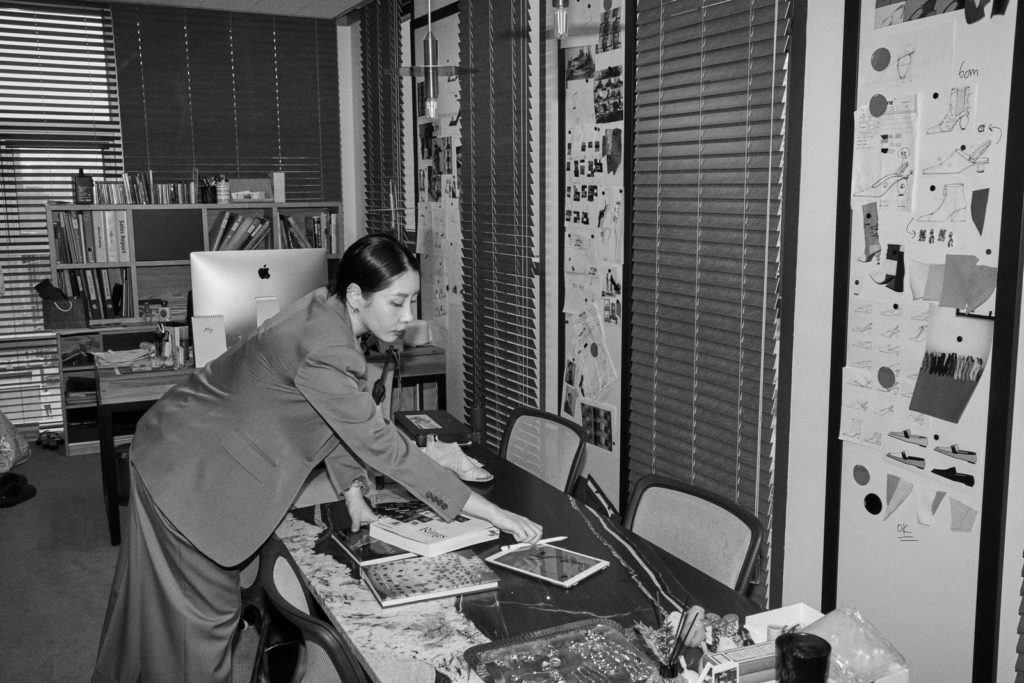Full disclosure: I have a playlist titled ‘Struttin’’ exclusively reserved for moments when I need a hit of self-affirmation to, well, strut. It contains tunes that range from upbeat ’70s classics like Redbone’s ‘Come and Get Your Love’ to sassier electronic tracks by Honne.
The sartorial equivalent of this playlist is my choice of footwear for the day. My shoes dictate the way I move through the day—choose sneakers and I’ve set an intention: a day of uninterrupted errand-running that requires me to be on my feet. Opt for heels and I’ve committed to a day of precarious but nonetheless empowered strides.
The maestros behind the shoes we wear are all too familiar with the power of wearing shoes. Sandra Choi, creative director at the helm of Jimmy Choo, shares: “Putting on a shoe can give a woman so much confidence. A little lift in a heel transforms you physically and mentally.”

I can attest to that. That shift in posture when I step into my favourite strappy mules—the way I extend languidly into my best self—is something no chiropractor could ever do. I might not be sashaying like Shalom Harlow anytime soon, but the dose of confidence I feel when I’m in any of my elevated footwear (be it my platform Tevas or my white gogo boots) is not something I can deny.
Cult shoe brand, Yuulyie—best known for its sculptural, experimental yet ultra-wearable heels—is no stranger to the allure of shoes, particularly the high heel. “The symbolism of the high heel today lies in individual freedom and attitude. In today’s world, everyone regardless of gender has access to high heels,” says Sunyuul Yie, founder and director of the South Korean label. “The atmosphere that only high heels can provide is way more thrilling than any other accessory and that is thrilling in itself.”

The fascination surrounding footwear is perhaps best encapsulated through the high heel—the single most feminised and fetishised type of shoe in popular culture. Its associations to pain and pleasure are front and centre. For an orthopaedically divisive shoe, there remains the placebo of empowerment that comes with wearing high heels.
Christian Louboutin, whose eponymous brand has built an empire solely (pun intended) based on shoes, believes that a good shoe is one that is a seamless extension of its wearer. “I’m not the one empowering women, they are the ones empowering themselves. I’m a designer offering them some tools to be the women they want to be,” he tells us.
“The shoe is the pedestal of your body, but also an introduction to your personality. They directly influence your attitude, the way you walk and the way you present yourself to others,” says Louboutin. “Shoes allow you to be whatever character you dream to be.”

From more folkloric roots in fairy tales and literary classics (think Cinderella, Puss in Boots and Dorothy’s red shoes) to ties to gender expression, the ways that different shoes are perceived today is telling of the narrative power of this underestimated accessory. And shoe design harnesses just that, while mastering a delicate balance with function.
For Choi, designing a shoe is like architecture. “I spend a lot of time perfecting our heels to ensure they are comfortable for the wearer,” she says. “I want people to feel confident, whether it’s flats, sneakers, kitten heels or platforms.”
Over in Italian luxury, Tod’s has breathed sensuality back into the craft of shoemaking through an unlikely hybrid of moccasins and pumps. “I obsessively take care of the study of details of craftsmanship and the processing of hides,” says Walter Chiapponi, creative director of the brand. “We return to a more ‘atelier’ and exclusive [approach].”

Beyond utility, the challenge that all shoemaking mavens have to consider is one that is obvious but crucial—space to dream, literally. “Designing a shoe is creating a lot of emotions and feelings… on a very small surface,” says Louboutin.
In a time when the bottom halves of my outfits haven’t occupied quite as much visual real estate as before, the seemingly mundane act of wearing shoes feels almost restorative. My shoes, more than ever, are now the interim between my indoor and outdoor selves—apart from my mask, they’re the last things I put on and the first things I take off.
“Shoes probably play the most important role in quenching our thirst [for normalcy],” Yie muses. “The stagnation of such unprecedented times has let me focus deeply on the basics, but also driven me to re-explore myself.”




In a similar vein, Chiapponi sees shoes as portals to normalcy. “The return to normality after lockdown, as we’ve seen on the streets, is a more emotional and sensitive return,” he observes. “Shoes represent the idea of us being able to live, work and enjoy life with friends and family again.”
Walk a mile in their shoes, they said. And walk a mile in the shoes of the minds who adorn our gaits, I did. With travel struck off our calendars this year, seeing shoes as transportive in a year of stasis is an attitude I can get on board with. Until we invent a means to teleport, our shoes are the next best option to an immersive playlist filled with your favourite tracks. Here’s an old but gold suggestion to kick off your own playlist to go along with your next pair of lift-me-up shoes: ‘These Boots Are Made For Walkin’ by Nancy Sinatra is a good place to start.





